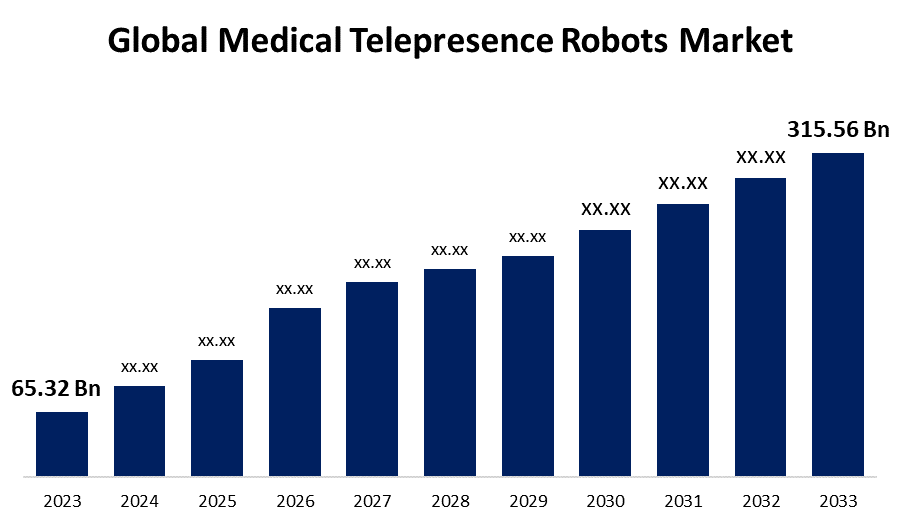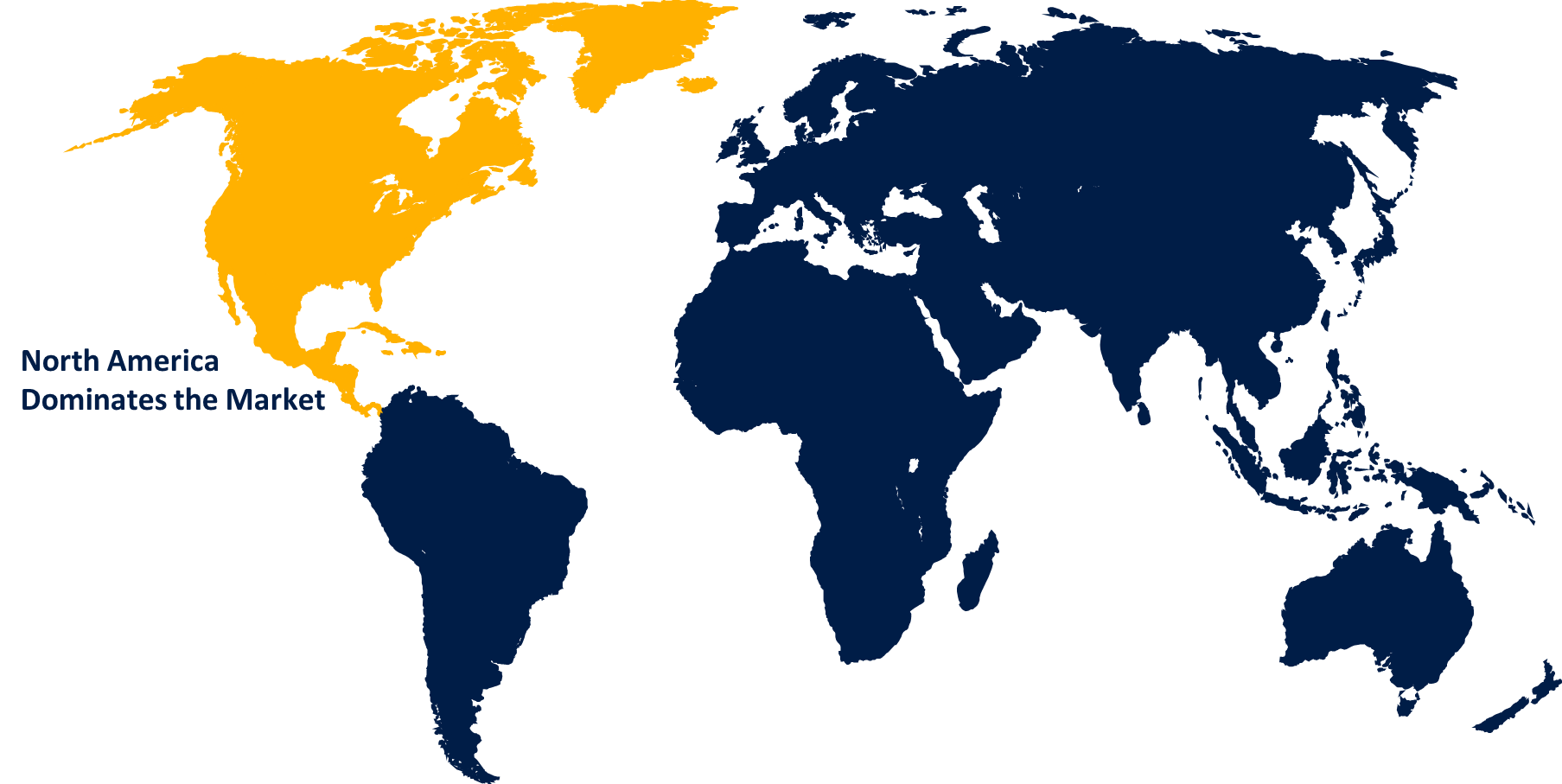Global Medical Telepresence Robots Market Size, Share, and COVID-19 Impact Analysis, By Type (Stationary, Mobile), By Body (Sensor, Power Source, Control Systems), By End-User (Hospitals, Clinics, Rehabilitation Centers), and By Region (North America, Europe, Asia-Pacific, Latin America, Middle East, and Africa), Analysis and Forecast 2023 - 2033.
Industry: HealthcareGlobal Medical Telepresence Robots Market Insights Forecasts to 2033
- The Global Medical Telepresence Robots Market Size was Valued at USD 65.32 Million in 2023
- The Market Size is Growing at a CAGR of 17.06% from 2023 to 2033
- The Worldwide Medical Telepresence Robots Market Size is Expected to Reach USD 315.56 Million by 2033
- Asia Pacific is Expected to Grow the fastest during the forecast period.

Get more details on this report -
The Global Medical Telepresence Robots Market Size is Anticipated to Exceed USD 315.56 Million by 2033, Growing at a CAGR of 17.06% from 2023 to 2033.
Market Overview
A medical telepresence robot is a sophisticated remote-controlled instrument meant for facilitating virtual presence and communication inside medical environments. These robots, which come with speakers, cameras, microphones, and a display screen, enable medical practitioners to work together in real-time with medical teams, perform virtual rounds, and consult with patients from a distance. They let physicians evaluate patients, talk about treatment options, and give medical advice without having to be physically present by moving around hospital rooms or clinics. In an environment where access to healthcare is restricted, such as in rural regions or during infectious disease outbreaks, medical telepresence robots are especially helpful since they lessen the need for physical contact which lowers the danger of contamination.
Report Coverage
This research report categorizes the market for the global medical telepresence robots market based on various segments and regions forecasts revenue growth and analyzes trends in each submarket. The report analyses the key growth drivers, opportunities, and challenges influencing the global medical telepresence robots market. Recent market developments and competitive strategies such as expansion, product launch, and development, partnership, merger, and acquisition have been included to draw the competitive landscape in the market. The report strategically identifies and profiles the key market players and analyses their core competencies in each sub-segment of the global medical telepresence robot market.
Global Medical Telepresence Robots Market Report Coverage
| Report Coverage | Details |
|---|---|
| Base Year: | 2023 |
| Market Size in 2023: | USD 65.32 Million |
| Forecast Period: | 2023 - 2033 |
| Forecast Period CAGR 2023 - 2033 : | 17.06% |
| 2033 Value Projection: | USD 315.56 Million |
| Historical Data for: | 2019-2022 |
| No. of Pages: | 231 |
| Tables, Charts & Figures: | 110 |
| Segments covered: | By Type, By Body, By Region |
| Companies covered:: | InTouch Health (Teladoc Health), iRobot Corporation, Anybots Inc., Awabot, Double Robotics, VGo Communications, Revolve Robotics, Suitable Technologies, Xenex Disinfection Services, Omron Corporation, Intuitive Surgical, Aethon, Cyberdyne Inc., SoftBank Robotics, Keenon Robotics, and Others |
| Pitfalls & Challenges: | Covid 19 Impact Challanges, Future, Growth and Analysis |
Get more details on this report -
Driving Factors
Numerous factors will boost the growth of the medical telepresence robot market globally. They facilitate communication between medical staff members and patients, as well as between medical teams in various places increasing access to specialist treatment in rural or distant areas. Also, these robots offer real-time patient monitoring that allows for swift medical intervention, if necessary, which is critical for controlling chronic illnesses or providing post-surgical care. By eliminating the need for travel, hospital stays, and in-person consultations, they contribute to the reduction of healthcare expenditures and increase accessibility and affordability of healthcare.
Restraining Factors
Several restraining factors will inhibit the growth of the medical telepresence robot market globally. Telepresence robots can be costly to acquire, install, and maintain which makes them unaffordable for smaller healthcare institutions or those with restricted finances. Also, they rely on cutting-edge technology and dependable internet access. Any technological issues, including device malfunctions, software bugs, or connectivity issues can impair patient care and interfere with communication. These robots cannot substitute hands-on treatment, physical exams, or procedures that require direct human interaction.
Market Segmentation
The global medical telepresence robots market share is classified into type, body, and end-user.
- The mobile segment is expected to hold the largest share of the global medical telepresence robots market during the forecast period.
Based on the type, the global medical telepresence robot market is divided into stationary, and mobile. Among these, the mobile segment is expected to hold the largest share of the global medical telepresence robot market during the forecast period. Mobile telepresence robots can move around a healthcare institute or a patient's home which allows increased flexibility for remote consultations, patient monitoring, and engagement with healthcare providers. Mobile robots offer more interactive and individualized treatment by following a patient or moving to different areas within a home or hospital environment. Also, continuous advancements in robot navigation, autonomy, and battery life make mobile telepresence robots more dependable and user-friendly.
- The sensor segment is expected to grow at the fastest CAGR in the global medical telepresence robots market during the forecast period.
Based on the body, the global medical telepresence robots market is divided into sensor, power source, and control systems. Among these, the sensor segment is expected to grow at the fastest CAGR in the global medical telepresence robots market during the forecast period. Sensors are critical for telepresence robots to successfully interact with their surroundings and patients. High-tech sensors that can precisely sense and react to their environment and their increasing demand will create intelligent and capable medical robots. Also, they play a major role by facilitating robots to execute complicated tasks such as navigation, obstacle detection, facial recognition, and patient monitoring. Continuous improvement in sensor technology especially in the creation of more precise, dependable, and cost-effective sensors, is propelling their use in telepresence robotics.
- The hospitals segment is expected to grow at the fastest CAGR in the global medical telepresence robots market during the forecast period.
Based on the end-user, the global medical telepresence robots market is divided into hospitals, clinics, and rehabilitation centers. Among these, the hospitals segment is expected to grow at the fastest CAGR in the global medical telepresence robots market during the forecast period. Hospitals use telepresence robots for a variety of purposes, including remote consultations, virtual rounds, patient monitoring, surgical aid, and infection control which makes them the largest and most diverse end-user group. These robots are important medical devices used for increasing efficiency, improving patient care, and managing high patient numbers majorly in big or multi-specialty medical institutions.
Regional Segment Analysis of the Global Medical Telepresence Robots Market
- North America (U.S., Canada, Mexico)
- Europe (Germany, France, U.K., Italy, Spain, Rest of Europe)
- Asia-Pacific (China, Japan, India, Rest of APAC)
- South America (Brazil and the Rest of South America)
- The Middle East and Africa (UAE, South Africa, Rest of MEA)
North America is anticipated to hold the largest share of the global medical telepresence robots market over the predicted timeframe.

Get more details on this report -
North America is anticipated to hold the largest share of the global medical telepresence robots market over the predicted timeframe. The United States has a highly sophisticated healthcare system that adopts modern technology like telepresence robots. Hospitals, clinics, and other healthcare institutions in the region are ready to incorporate this technology into their operations. Also, the region has one of the largest healthcare expenditures per capita which allows for major investments in cutting-edge healthcare technologies such as telepresence robotics. The region’s increasing elderly population is driving up demand for home healthcare and remote monitoring solutions in which telepresence robots play a major role.
Asia Pacific is expected to grow at the fastest pace in the global medical telepresence robots market during the forecast period. Many Asia-Pacific nations are making significant investments in and modernizing their healthcare infrastructure, generating demand for innovative healthcare technology such as telepresence robots. Also, telemedicine is gaining popularity in this region due to both government initiatives and business sector investment. Telepresence robots play an important role in telemedicine initiatives, including remote consultation, monitoring, and care. The COVID-19 pandemic accelerated the region's adoption of remote healthcare systems driving further growth in the telepresence robot market.
Competitive Analysis:
The report offers the appropriate analysis of the key organizations/companies involved within the global medical telepresence robots market along with a comparative evaluation primarily based on their product offering, business overviews, geographic presence, enterprise strategies, segment market share, and SWOT analysis. The report also provides an elaborative analysis focusing on the current news and developments of the companies, which includes product development, innovations, joint ventures, partnerships, mergers & acquisitions, strategic alliances, and others. This allows for the evaluation of the overall competition within the market.
List of Key Companies
- InTouch Health (Teladoc Health)
- iRobot Corporation
- Anybots Inc.
- Awabot
- Double Robotics
- VGo Communications
- Revolve Robotics
- Suitable Technologies
- Xenex Disinfection Services
- Omron Corporation
- Intuitive Surgical
- Aethon
- Cyberdyne Inc.
- SoftBank Robotics
- Keenon Robotics
- Others
Key Target Audience
- Market Players
- Investors
- End-users
- Government Authorities
- Consulting And Research Firm
- Venture capitalists
- Value-Added Resellers (VARs)
Recent Developments
- In March 2024, Bomet County collaborated with World Tele-Health (WTI) to launch telemedicine robots in Longisa County Referral Hospitals and other healthcare facilities in Kenya.
- In June 2023, Touchlabs a Scottish deep-tech startup developed a telerobot especially designed to feel patients equipped with electronic skin technology.
Market Segment
This study forecasts revenue at global, regional, and country levels from 2020 to 2033. Spherical Insights has segmented the global medical telepresence robots market based on the below-mentioned segments:
Global Medical Telepresence Robots Market, By Type
- Stationary
- Mobile
Global Medical Telepresence Robots Market, By Body
- Sensor
- Power Source
- Control Systems
Global Medical Telepresence Robots Market, By End-User
- Hospitals
- Clinics
- Rehabilitation Centers
Global Medical Telepresence Robots Market, Regional
- North America
- US
- Canada
- Mexico
- Europe
- Germany
- Uk
- France
- Italy
- Spain
- Russia
- Rest of Europe
- Asia Pacific
- China
- Japan
- India
- South Korea
- Australia
- Rest of Asia Pacific
- South America
- Brazil
- Argentina
- Rest of South America
- Middle East & Africa
- UAE
- Saudi Arabia
- Qatar
- South Africa
- Rest of the Middle East & Africa
Need help to buy this report?